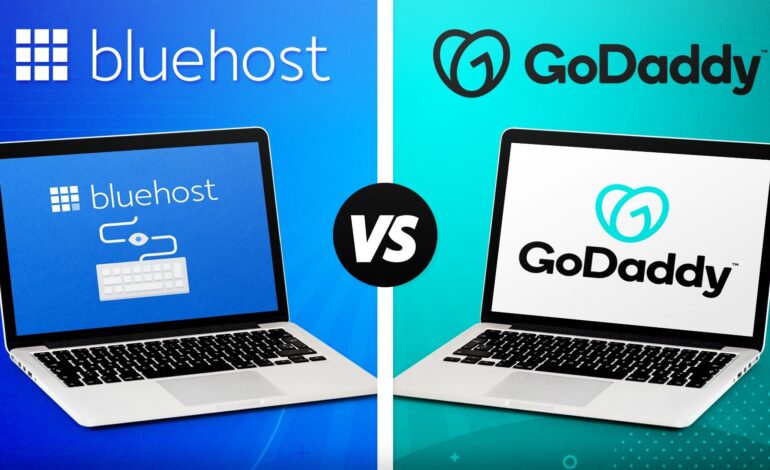
Choosing the right web hosting provider is a critical decision for anyone looking to establish an online presence. Two of the most popular hosting providers in the market are GoDaddy and Bluehost. Both are industry giants, offering a variety of services including domain registration, shared hosting, WordPress hosting, and more. But which one is right for you? This article will dive deep into their features, pricing, performance, customer support, and more to help you decide.
Overview of GoDaddy and Bluehost
GoDaddy
GoDaddy is a well-known name in the domain registration and web hosting space. Established in 1997, it boasts a wide range of hosting plans suitable for small businesses, personal websites, and even large-scale enterprises. Its user-friendly interface and marketing tools make it a popular choice among beginners and entrepreneurs.
Key Highlights of GoDaddy:
- Over 20 million customers worldwide
- Comprehensive website-building tools
- Excellent domain registration services
- Wide variety of hosting options
Bluehost
Bluehost, founded in 2003, is officially recommended by WordPress.org, making it a go-to choice for WordPress users. It offers affordable hosting plans with robust features designed to support small to medium-sized websites.
Key Highlights of Bluehost:
- Endorsed by WordPress.org
- Strong focus on customer support
- Seamless WordPress integration
- Free SSL certificates and CDN
Features Comparison
| Feature | GoDaddy | Bluehost |
|---|---|---|
| Domain Registration | Free for the first year (with hosting plan) | Free for the first year (with hosting plan) |
| Hosting Plans | Shared, VPS, Dedicated, WordPress, Reseller | Shared, VPS, Dedicated, WordPress |
| Ease of Use | Intuitive interface, custom website builder | Beginner-friendly with a clean cPanel interface |
| Performance | 99.9% uptime, but performance may vary based on plan | Consistently strong uptime and fast loading speeds |
| Customer Support | 24/7 support via phone and live chat | 24/7 support via phone, live chat, and ticket system |
| Freebies | Free domain (1 year), email marketing tools | Free SSL, CDN, domain (1 year), and $200 marketing credit |
| WordPress Hosting | WordPress hosting available but not as optimized | Officially recommended by WordPress.org, offering seamless integration |
| Money-Back Guarantee | 30-day money-back guarantee | 30-day money-back guarantee |
Detailed Comparison
1. Pricing and Plans
Both GoDaddy and Bluehost offer competitive pricing, but the value you get from their plans can differ.
- GoDaddy: Its basic shared hosting starts at $5.99/month, offering unmetered bandwidth and 100 GB storage. However, add-ons like SSL certificates and backups often cost extra.
- Bluehost: Bluehost’s Basic plan starts at $2.95/month (introductory pricing) and includes a free SSL, free CDN, and 50 GB SSD storage. Bluehost provides more inclusive features at lower initial costs.
Winner: Bluehost for better value at entry-level plans.
2. Performance
A website’s speed and uptime directly impact user experience and search engine rankings.
- GoDaddy: Offers a 99.9% uptime guarantee but sometimes lags behind in speed consistency.
- Bluehost: Known for its reliability, Bluehost boasts excellent uptime and fast loading speeds, thanks to SSD storage and integrated CDN.
Winner: Bluehost for more consistent performance.
3. Ease of Use
Both providers cater to beginners with easy-to-use interfaces, but their approaches differ.
- GoDaddy: Features a proprietary website builder with drag-and-drop functionality, ideal for those with minimal technical knowledge.
- Bluehost: Provides a clean cPanel and one-click WordPress installation, making it beginner-friendly while offering advanced customization options.
Winner: Tie—GoDaddy is better for complete beginners, while Bluehost excels for WordPress users.
4. Customer Support
Customer support is crucial when troubleshooting hosting issues.
- GoDaddy: Offers 24/7 support via phone and live chat but has received mixed reviews about response times and effectiveness.
- Bluehost: Provides 24/7 support via multiple channels, including phone, live chat, and tickets, and is known for its knowledgeable and helpful support team.
Winner: Bluehost for consistently better support.
5. WordPress Hosting
For WordPress users, the choice is clear.
- GoDaddy: Offers WordPress hosting but lacks the depth of optimization and tools that Bluehost provides.
- Bluehost: As a WordPress-recommended host, Bluehost ensures seamless integration, advanced caching, and automatic updates for WordPress sites.
Winner: Bluehost, especially for WordPress websites.
6. Additional Features
Both hosts offer extra features to enhance your experience.
- GoDaddy: Provides extensive marketing tools, including email campaigns and SEO add-ons.
- Bluehost: Includes free SSL certificates, CDN integration, and $200 marketing credits, adding significant value to their plans.
Winner: Bluehost for more generous inclusions.
Pros and Cons
GoDaddy
Pros:
- Strong domain registration services
- Easy-to-use website builder
- Wide range of hosting plans
Cons:
- Add-ons can make plans more expensive
- Performance can be inconsistent
Bluehost
Pros:
- Excellent WordPress hosting
- Affordable, feature-packed plans
- Reliable performance and uptime
Cons:
- Higher renewal costs
- Limited storage on basic plans
Which Host is Right for You?
Choose GoDaddy if:
- You’re looking for a one-stop shop for domain registration and hosting.
- You prefer a user-friendly website builder.
Choose Bluehost if:
- You’re building a WordPress site and want seamless integration.
- You value performance, reliability, and customer support.
Final Verdict
While both GoDaddy and Bluehost have their strengths, Bluehost emerges as the better option for most users, particularly those using WordPress. Its combination of affordability, performance, and customer support make it a standout choice.
GoDaddy remains a solid option for those who prioritize domain registration and marketing tools. Ultimately, the right choice depends on your specific needs and budget.


